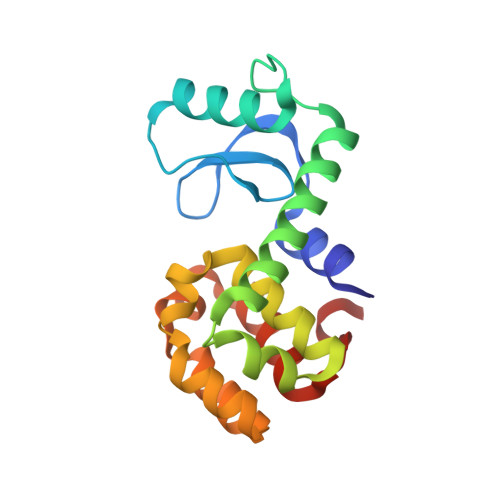Halogenated benzenes bound within a non-polar cavity in T4 lysozyme provide examples of I...S and I...Se halogen-bonding.
Liu, L., Baase, W.A., Matthews, B.W.(2009) J Mol Biol 385: 595-605
- PubMed: 19014950
- DOI: https://doi.org/10.1016/j.jmb.2008.10.086
- Primary Citation of Related Structures:
3DMV, 3DMX, 3DMZ, 3DN0, 3DN1, 3DN2, 3DN3, 3DN4, 3DN6, 3DN8, 3DNA - PubMed Abstract:
We showed earlier that the mutation of Leu99 to alanine in bacteriophage T4 lysozyme creates an internal cavity of volume approximately 150 A(3) that binds benzene and a variety of other ligands. As such, this cavity provides an excellent target to study protein-ligand interaction. Here, we use low-temperature crystallography and related techniques to analyze the binding of halogen-incorporated benzenes typified by C(6)F(5)X, where X=H, F, Cl, Br or I, and C(6)H(5)X, where X=H or I was also studied. Because of the increased electron density of fluorine relative to hydrogen, the geometry of binding of the fluoro compounds can often be determined more precisely than their hydrogen-containing analogs. All of the ligands bind in essentially the same plane but the center of the phenyl ring can translate by up to 1.2 A. In no case does the ligand rotate freely within the cavity. The walls of the cavity consist predominantly of hydrocarbon atoms, and in several cases it appears that van der Waals interactions define the geometry of binding. In comparing the smallest with the largest ligand, the cavity volume increases from 181 A(3) to 245 A(3). This shows that the protein is flexible and adapts to the size and shape of the ligand. There is a remarkably close contact of 3.0 A between the iodine atom on C(6)F(5)I and the sulfur or selenium atom of Met or SeMet102. This interaction is 1.0 A less than the sum of the van der Waals radii and is a clear example of a so-called halogen bond. Notwithstanding this close approach, the increase in binding energy for the halogen bond relative to a van der Waals contact is estimated to be only about 0.5-0.7 kcal/mol.
Organizational Affiliation:
Institute of Molecular Biology, Howard Hughes Medical Institute, University of Oregon, Eugene, OR 97403, USA

















